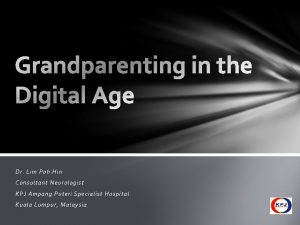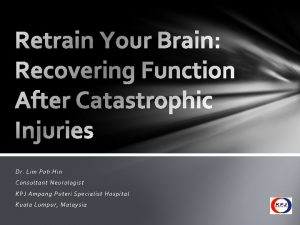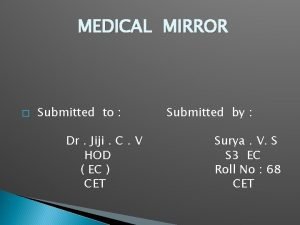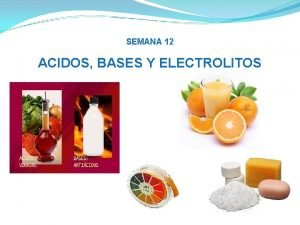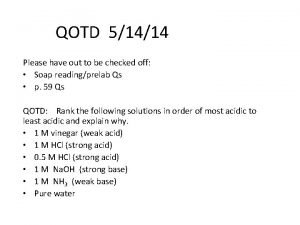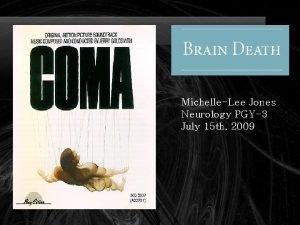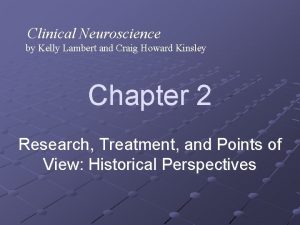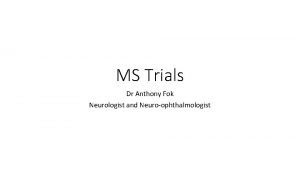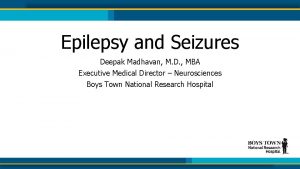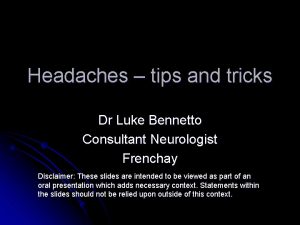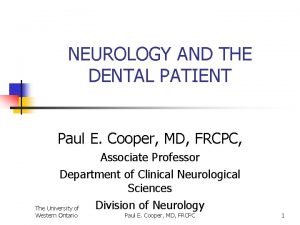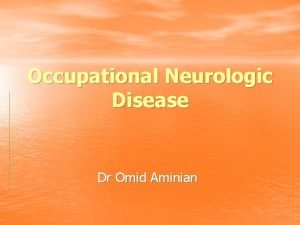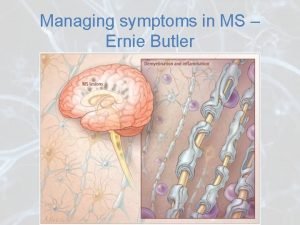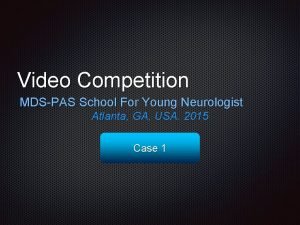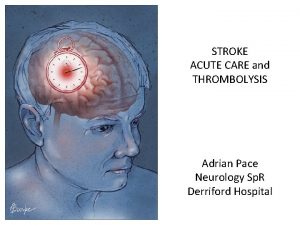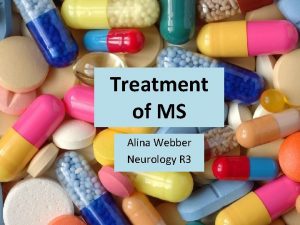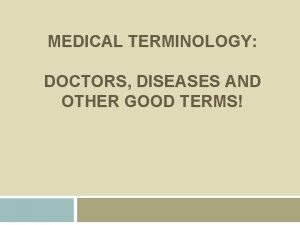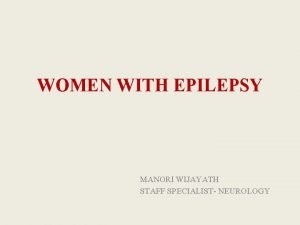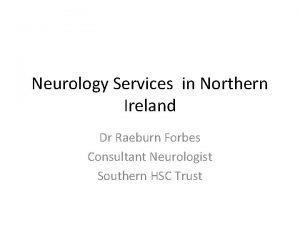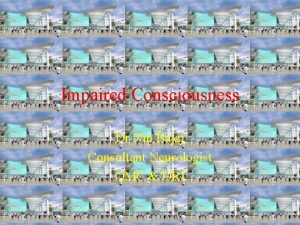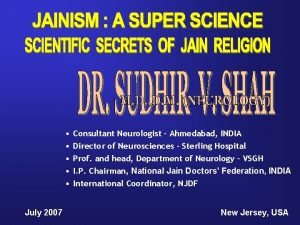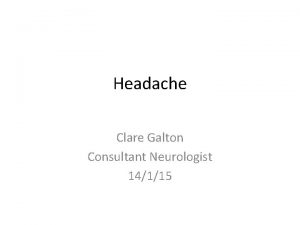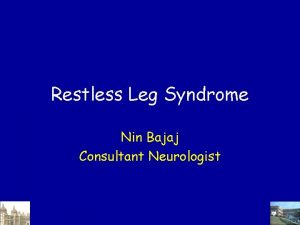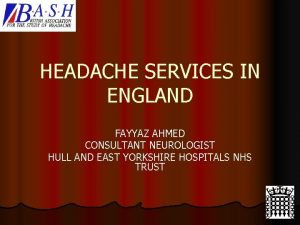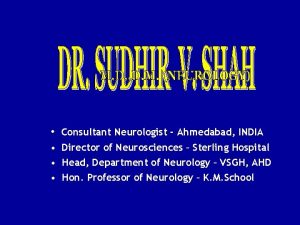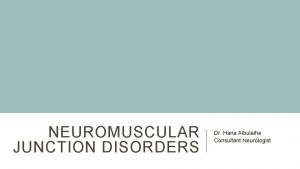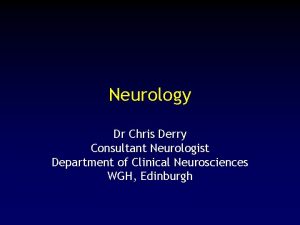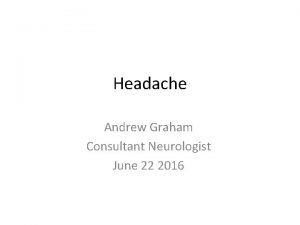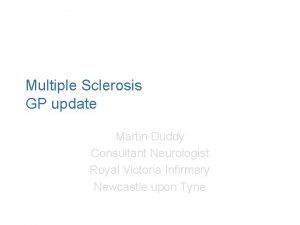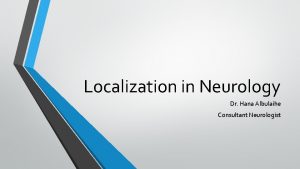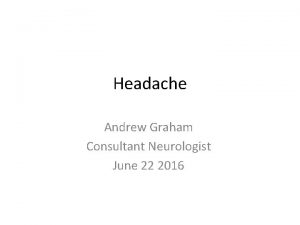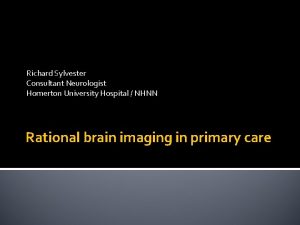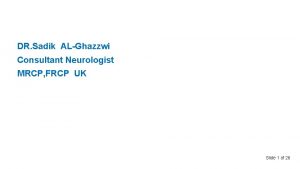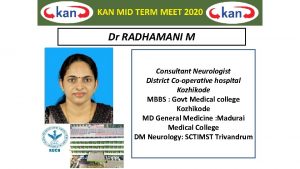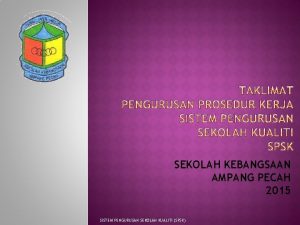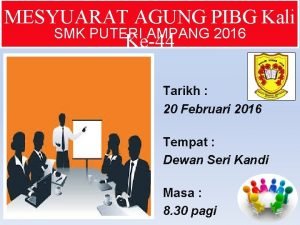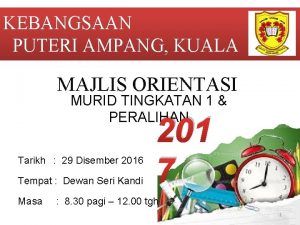Dr Lim Poh Hin Consultant Neurologist KPJ Ampang


























- Slides: 26

Dr. Lim Poh Hin Consultant Neurologist KPJ Ampang Puteri Specialist Hospital Kuala Lumpur, Malaysia

Neurological Rehabilitation Team • Neurologist/Rehabilitation Physician • Nurse Coordinator • Psychologist • Occupational therapist • Physiotherapist • Speech pathologist • Nutritionists • Social workers

Mechanisms of Neuronal Injury • Vascular (e. g. ischemic strokes, hemorrhages) • Traumatic (e. g. concussion, diffuse axonal injury) • Infections (e. g. encephalitis, meningitis, abscess) • Autoimmune ( e. g. cerebral lupus, multiple sclerosis) • Toxic (e. g. heavy metal poisoning) • Metabolic derangement (e. g. liver/renal failure) • Prolonged seizures/status epilepticus • Hypoxic-hypoperfusion (e. g. asphyxiation, heart failure)

Complexity, Indispensibility of Neurons • Brain & spinal cord neurons develop from embryologic neural crest with neurons migrating with very specific axonal and dendritic pathways • How many neurons in the brain? 100 billion or 86 billion? • How much of our brains is used? 10% or 100% • Do brain neurons regenerate? • If dead brain cells do not regenerate what mechanisms explain neurologic recovery?

Molecular Mechanism of Neuronal Injury • Cessation of electrophysiological activity • Switch from aerobic to anaerobic metabolism • Depletion of cellular ATP • Buildup of intracellular Na++, Ca++ concentration • Cytotoxic Ca++ mediated reaction • Release of excitatory neurotransmitters (e. g. glutamate) • Proteases, endonucleases, phopholipase, Nitrous oxide synthase activation, free radical formed • Cellular necrosis with edema & damage to surrounding tissues

Mechanism of Neuronal Cell Death

Then, brain cells are dead…

Neuroplasticity – How the Brain Recovers from Injury • Concept of retraining & adaptation of brain after injury • Brain not inflexibly hardwired • Regenerative changes occur following catastrophic events • Period of malleability is limited, lasting weeks to months • Neuroplasticity processes mirror or are similar to normal brain development during gestation and after birth (during development of the infant’s neurological system

Neuronal Development: Axonal Sprouting Complexity of brain neuronal connections • Axonal sprouting – neurons send their efferent processes – output to new locations during development in the human embryo • Guidance for axonal sprouting. • Interplay between somatosensory and motor systems • Triggered by guidance molecules • Cues based on behavioral demands and are activity dependent.

Mechanism of Axonal Guidance

Motor Function Development Thalamocortical connections directed by axonal guidance molecules • Spontaneous neuronal activity • Further axonal sprouting within cortex triggered by cortical activity • Determines cortical topographical connectivity patterns

Post Injury Neuroplasticity in Adult • Evidence of post injury axonal sprouting in rat model • Sprouting from intact hemisphere to perilesional tissue on the affected side and contralateral dorsal striatum. • Understanding processes involved in neuroplasticity after injury may provide opportunity to improve outcomes for rehabilitation • Idea of remapping the motor pathways through selectively activating rather than generally targeting all muscle activity • Temporal window of opportunity to act

Remapping Following Brain Injury • Plasticity allows brain to recover and adapt to deficits • Behavioral compensation – loss of function in digits compensated by shifting to proximal muscles/trunk • With repetitive movements (represented by intensive therapy) new remapping of digits occur adjacent to previous regions for digit control • Without repetitive movements proximal muscle representation enlarges

Remapping New Motor Function Nudo R. J. , Milliken G. W. , Jenkins W. M. , Merzenich M. M. (1996 a). Use-dependent alterations of movement representations in primary motor cortex of adult squirrel monkeys. J. Neurosci. 16, 785– 807 [Pub. Med]

Pre & Post Stroke Regional Remapping A. Fore limb & hind limb representation on motor cortex B. Hours to 1 week: effects of stroke on fore limb region on motor cortex C. 1 -4 weeks after stroke: reduction of region representing hind limb, expansion of fore limb representation in formerly neurons controlling hind limb D. Several weeks later, new remapped representation for motor control of hind and fore limbs

Context Dependent Reinforcement Context dependent reinforcement • Simple exposure sensory stimuli does not result in lasting changes • Animals given sensory stimuli (somatosensory/auditory) associated with reward show more lasting changes

Practical Considerations (Application) Repetitive muscle activity may help remapping, however: • Boring routines do not motivate • Individualized therapy utilizing personalized approach produce lasting improvement. • Rats: role of dopamine (linked to reward) improves motor memory consolidation • Human stoke patients improved procedural motor learning on levodopa

Dopamine & Neuroplasticity • Rat model – depletion of dopamine (6 -hydroxydopamine antagonism) resulted in impairment in learning to retrieve food pallet • Dopamine – neurotransmitter involved in “reward” center/pleasure center • Levodopa noted in stroke patients to improve procedural motor learning

Constraint Induced Movement Therapy (CIMT) “USE IT OR LOSE IT” TAUB et al. ‘s Concept of “Learned Non-Use” • Following paresis of limb, person will fail to be able to use paretic limb • Frustration from failure further discourages attempts to try to use • Instead, paretic person will favor normal side • Reduces the chance of better recovery of motor function due to less attempt to try to repetitively activate neurons on the paretic side.

Constraint Induced Movement Therapy (CIMT) • Effect can be demonstrated in animal models • Monkeys with restraints on non-paretic side had better recovery of function compared to monkeys with no restraint of hemiparetic side

CIMT in Humans • Accomplished by immobilizing non-paretic side with slings or mittens • Restraining 90% of waking hours • Getting patients to do physical activity while restrained • For speech, prohibiting communications via nonverbal means (e. g. gestures)

Temporal Factors in CIMT • Neuroplasticity – axonal sprouting starts 1 -3 days after stroke, ends possibly after 1 month • Rats – forced constraint immediately after stroke worse than if delayed slightly. • Improvement starting even years after stroke – however improvement is not as good as if started early (3 -9 months vs >15 months) • No benefit starting too early (<3 months)

Limitations of CIMT • Safety issues – without use of nonparetic side, patients may be at risk for more falls • Tolerability to patients – feelings of helplessness. Many cannot tolerate being constrained for 90% of waking hours

Real World Implications of Neuroplasticity Timing • Financial considerations • Funding for intensive inpatient rehabilitation • Public/private facilities • Financial compensation for accident injuries

Reading further… Recovery after brain injury: mechanisms and principles, Randolph J. Nudo. https: //www. ncbi. nlm. nih. gov/pmc/articles/PMC 3870954/ Constraint-induced movement therapy, Wikipedia. https: //en. wikipedia. org/wiki/Constraint-induced_movement_therapy

THANK YOU
 Dr lim poh hin
Dr lim poh hin Dr lim poh hin
Dr lim poh hin Seksyen 117 kpj
Seksyen 117 kpj Cessna 172r stall speed
Cessna 172r stall speed Rino poh ggz
Rino poh ggz Ph poh conversion chart
Ph poh conversion chart Ming-zher poh
Ming-zher poh Geong sen poh
Geong sen poh Que son los electrolitos
Que son los electrolitos Gongshang primary
Gongshang primary Poh
Poh Dr michelle lee jones neurologist
Dr michelle lee jones neurologist Is kelly clarkson a neuroscientist
Is kelly clarkson a neuroscientist Dr anthony fok
Dr anthony fok Deepak madhavan
Deepak madhavan Dr bennetto neurologist
Dr bennetto neurologist Neurologist delta dental
Neurologist delta dental Dr aminian neurologist
Dr aminian neurologist Ernie butler neurologist
Ernie butler neurologist Dr pearson neurologist
Dr pearson neurologist Adrian pace neurologist
Adrian pace neurologist Alina webber
Alina webber Gastrointernist
Gastrointernist Terratogenesis
Terratogenesis Neurology consultants northern ireland
Neurology consultants northern ireland Dr richard perry
Dr richard perry Dr richard perry neurologist
Dr richard perry neurologist
